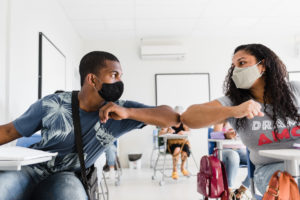I am a pediatric infectious diseases physician at Washington University in St. Louis and St. Louis Children’s Hospital. Throughout the pandemic, I have spent time evaluating COVID-19 transmission in schools and advising schools on the best COVID-19 mitigation practices.
As a pediatric infectious diseases physician in St. Louis, MO, I am experiencing firsthand the impacts of the current COVID-19 surge and the delta variant. It has never been more important for all of us to come together to protect children and families, prevent serious illness and death, and allow in-person learning to proceed safely. As trusted leaders in their communities, principals have an important voice and can help facilitate an environment that is supportive of the measures we must adopt to end the pandemic, including vaccination and mask wearing.
Most of the country is currently experiencing high rates of COVID-19 transmission, with the vast majority of cases, hospitalizations, and deaths occurring among unvaccinated individuals. While most children who contract COVID-19 have only mild disease, some become seriously ill. However, throughout the country, children’s hospitals have now admitted more children with acute COVID-19 as a result of the delta variant. Additionally, multisystem inflammatory syndrome in children (MIS-C) is a very serious complication that can occur four to six weeks following a mild COVID-19 infection. MIS-C typically requires hospitalization and is life-threatening. As the delta variant is much more transmissible than previous strains of the virus, layered prevention strategies that include vaccination, mask wearing, ventilation, distancing, and hand hygiene are essential.
We do have reasons for optimism as students return to school. We now have tools and knowledge to prevent COVID-19 that we lacked earlier in the pandemic, and principals are important partners to help us implement them in schools. As principals speak with their staff, students, and families at the start of this school year, I offer some messages and strategies they can use to prevent COVID-19 transmission in their schools.
First, all eligible individuals should get vaccinated. Many schools are already promoting vaccination and hosting on-site vaccination clinics to make it easy to get vaccinated. It is also important to provide staff and students time off for vaccination. I encourage principals to empathize with people who may have questions about the vaccine and to respond in a nonjudgmental and fact-based manner, emphasizing the vaccines’ strong safety and efficacy data. Breakthrough infections are rare and when they do occur, they are almost always mild. Individuals with breakthrough infections can transmit the virus to others, underscoring the importance of layering multiple prevention strategies. Vaccines protect individuals and the community by reducing transmission, which is especially important to protect children too young to be vaccinated.

With high transmission rates in much of the country, combining multiple prevention strategies is the best way to prevent infection and allow safe in-person learning. Masks are effective at preventing transmission. Masks should fit snugly and cover the nose and mouth. Like all community mitigation measures, mask wearing is most effective when everyone participates. Masking everyone, regardless of vaccination status, relieves any burden on schools to try to verify individuals’ vaccination status and provides the best possible protection against infection. Data from the previous school year show that masking, especially when combined with distancing (3 feet is enough), hand hygiene, good ventilation, being outdoors whenever possible, and not having students and staff attend school when sick was successful in preventing transmission in schools.
To help encourage mask wearing, schools can provide masks for staff, students, or families who may not be able to afford them or forgot them at home. Principals can also consider ways to make masking fun in their schools. For example, sell masks with your school’s name on them as a fundraiser, hold contests for the coolest masks, and host spirit days in which people are encouraged to wear masks of the school’s colors.
I hope our response to this pandemic can help strengthen community bonds, as we must all work together to stop the spread of COVID-19 and keep our children healthy and thriving. Principals are critical leaders of this work, and I encourage them to rely on and partner with the Centers for Disease Control and Prevention, state and local health departments, the Infectious Diseases Society of America, the American Academy of Pediatrics, the Pediatric Infectious Diseases Society, and local physicians.
Additional Resources:
- ABC Science Collaborative has reports and FAQs on safe in-person learning.
- Washington University Pediatric & Adolescent Ambulatory Research Consortium provides information about COVID-19 transmission in schools and an algorithm to support safe decision-making in schools.
- CDC Guidance for COVID-19 Prevention in K–12 Schools
- American Academy of Pediatrics COVID-19 Guidance for Safe Schools.

